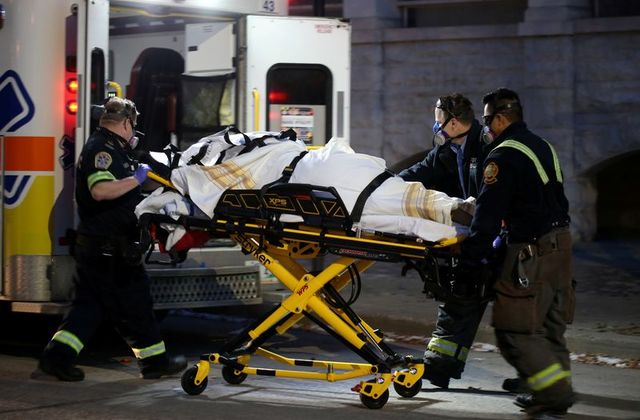WINNIPEG, (Reuters) – In July, the Canadian province of Manitoba went two weeks without a single new case of COVID-19. Theaters and casinos reopened and children soon returned to school.
By October, the 1.4 million people living in a province only slightly smaller geographically than Texas had Canada’s highest rate of active cases – now 512 per 100,000 people, or nearly quadruple the national rate.
“In a couple of weeks, we’re going to be in a catastrophic situation,” said Dr. Anand Kumar, a Manitoba intensive care physician.
Many Americans looked longingly north of the border during the pandemic’s first wave, as Canada kept COVID-19 infections and hospitalizations under control while they skyrocketed in the United States. But Canadians’ exhaustion with pandemic restrictions is now coinciding with an outbreak that threatens to overwhelm health systems in several provinces.
Canada has recorded over 302,000 cases and more than 11,000 deaths during the pandemic. Nationally, there were 1,114 COVID-19 patients in hospital as of Nov. 3, well below a spring peak of 2,701 but double what they were a month ago.
At this pace, Canada’s daily case tally may more than double by early December, health officials warned last week.
The situation is already turning dire in Manitoba, where community transmission is so rampant through care homes, hospitals and family gatherings that health officials are unable to identify the main sources.
In Manitoba’s capital Winnipeg, with a population of 750,000, Kumar sees a trend similar to the outbreaks that overwhelmed New York City in the spring and currently El Paso, Texas, requiring freezer trucks to store bodies as they piled up.
Manitoba’s single-day record of 508 cases on Nov. 10 is triple the total from two weeks earlier, with intensive care units (ICU) nearly full.
“Once you go past ICU capacity, the mortality rate shoots right up like a rocket,” said Kumar, who is trained in treating infectious diseases and in critical care.
Manitoba plans to set up makeshift hospitals in arenas or convention centers to accommodate overflow patients.
“This is becoming more distressing every day,” said Manitoba’s Chief Nursing Officer Lanette Siragusa. “If we had a worst-case scenario, this would be it.”
Alberta, home of Canada’s second-highest rate of current cases, has seen hospitalizations and infections requiring intensive care surge past earlier highs, including outbreaks in 10 hospitals.
‘A RECIPE FOR DISASTER’
In Quebec, which has Canada’s highest rate and number of deaths, some infected seniors at nursing homes with outbreaks are being moved to other facilities, raising fears of viral spread.
Ontario’s active cases are climbing even as the province has tightened restrictions on a growing number of regions.
Manitoba has re-imposed business restrictions and suspended hundreds of surgeries. But stores allowed to operate were packed last weekend as staff ignored capacity limits, said Chief Public Health Officer Dr. Brent Roussin.
Medical staffing is a major concern, with nurses working overtime and extra shifts, leading to exhaustion and additional risk. At least 100 nurses have become infected in this second wave, said Manitoba Nurses Union President Darlene Jackson.
“It’s really likely that the (Winnipeg) hospital sector will be facing overwhelming conditions for some time,” Anthony Dale, president of the Ontario Hospital Association, said.
Quebec and Ontario combined account for half of Canada’s active COVID-19 cases and 90% of related fatalities.
Health authorities are directing some Montreal-area nursing facilities that have vacancies due to deaths during the first wave to admit infected non-residents from other places that lack space or face outbreaks.
Administrators say those who do not require hospitalization are being placed in “hot zones” that have separate staffing, beds and entrances.
One Laval, Quebec facility took in 10 patients this month from nearby residences that need to isolate people who test positive, said Judith Goudreau, a spokeswoman for the area’s health board.
“There are so many reasons why this is a recipe for disaster,” said Joyce Shanks, whose father lives at a long-term care facility in Montreal that has not yet admitted outside residents.
The number of infected patients remains manageable, said the FSSS-CSN, a Quebec union that represents orderlies.
“The question is how widespread it’s going to be,” union President Jeff Begley said.
The latest modelling projects 6,500 new cases per day in Ontario by the end of December if no action was taken. Public health experts are not optimistic about the current situation.
“Hospitals are coping but there isn’t a great deal of wiggle room,” said Dr. Howard Ovens, chief medical strategy officer for Sinai Health System in Toronto.
A trend showing more people 50 and older becoming sick is especially troubling because they are most likely to require hospital stays, filling beds quickly, said Dr. Lynora Saxinger, an infectious disease specialist at University of Alberta.
“It really can change on a dime.”

